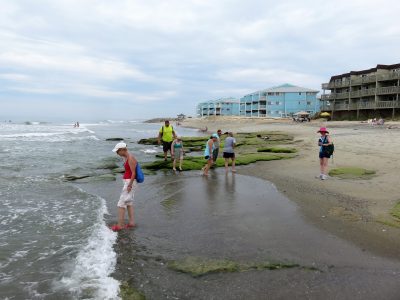
Second of two parts
Geologist Roger Shew doesn’t have to go far to get to what he considers the best example of the challenges along North Carolina’s beaches.
Supporter Spotlight
Shew, a University of North Carolina Wilmington researcher and lecturer who teaches coastal geology, said there’s no better place than the stretch along the southern reaches of Pleasure Island where Fort Fisher abuts Kure Beach, the coquina rocks and The Riggings condominiums.
“I tell people if you want to see most of the issues on the coast we face, I can take you to Kure Beach and show you most everything that is going on, on the beach,” he said. “You have structures, seawalls, longshore (sand) transport and re-nourishment.”
Then there’s the Atlantic Ocean. The southern point of the island has intense wave action and, with it, much higher erosion rates.
Shew said that just south of the Fort Fisher seawall, erosion rates run about 9½ feet per year, compared to the re-nourished beaches at Carolina Beach and Wrightsville Beach, which average about 2 feet per year.
Shew has been studying nuisance flooding in the Cape Fear region, its effect on infrastructure and the implications for planning given environmental changes like sea level rise. He’s been documenting the perigean spring tides and other high tides in the area and was at Kure Beach for the new moon on July 13, about an hour before the peak of the most recent maximum tide.
Supporter Spotlight
“I was standing in front of The Riggings condominiums and waves were lapping well up onto the sandbags,” he said. He collected photos to use this fall when he talks about erosion, development and processes on the beach.
Shew said that while any location proximate to the beach comes with risk, what’s happening at The Riggings is no surprise.
“In this particular case, it was obvious that it was a risky location,” he said, citing the need for a sandbag wall to protect the buildings within just a few years of construction. “Most people realized that the erosion rate was high to start with.”
Shew said he understands the difficulties the property owners have had in reaching an answer.
“You’ve got to sympathize with them, they’ve invested in something. They (the condos) would be worth a lot more if they were not jeopardized.”
The North Carolina General Assembly may have offered a temporary solution by allowing the state Coastal Resources Commission the option to approve repair or replacement of the sandbag wall, but long term, Shew said there aren’t a lot of options, given that federal funds have dwindled and another buyout to retreat across U.S. 421 is unlikely. Also unlikely is a hardened structure such as a groin, which would also require extensive studies as well as a change in state law.
“Without being able to retreat or put in hardened structures, re-nourishment is really the only game in town,” he said. But given the conflict with the coquina rock outcropping, any project would face a potential deal breaker.
Shew said he believes the outcropping, which was declared a state Natural Heritage Area in 1982, should be protected.
“If you go down there at low tide, extreme low tide, it’s just like a rocky tide pool up in New England, where you can see sea anemones, starfish, lipids up on those rocks,” he said. “It’s really a classic kind of area and the only one in North Carolina and for a long ways where you can actually see a rock on the beach that’s naturally occurring.”
Preparing an application for a new re-nourishment project would take time and money and require new environmental studies.
Shew said trucking in sand for spot placement, another re-nourishment alternative being considered, is also unlikely to work, even if it’s placed outside the coquina rock area, he said.
“In this particular case, it was obvious that it was a risky location.”
Roger Shew, UNCW geology professor
“Because it is such a high-energy area, much of that sand would be removed relatively quickly,” he said, referring to the wave action.
Another rock wall or a groin would only exacerbate the sand flow problem, he said, and set a precedent that would allow for more hardened structures. Shew said it is doubtful one would be approved for The Riggings area and to do so would require a change in state law.
“I just don’t believe any of those things would work,” he said of the options. “I would hate for North Carolina to go back on the rule (against hardened structures).”
The reality on the coast is that anything you do has to be repeated, Shew said. “If you do anything on the beach you have to keep doing it. If you’re going to re-nourish, you’re going to have to keep re-nourishing if you’re going to put in structures, you’re going to have to put in more structures and/or keep re-nourishing to protect that structure”
Rules in Flux
Like the sandbags at The Riggings, the state’s rules on temporary erosion structures have been shifting around.
In recent years, the legislature has required rule changes to extend the time limits for the structures and widen the types of locations where they’re allowed.

During its meeting Sept. 19-20, the commission is expected to get its official first look at the new law aimed at The Riggings.
Mary Lucasse, a special deputy attorney general and counsel for the CRC, said commission members are to be briefed on how the law changes state law repair and replacement of the structures. But the discussion won’t dig into the specifics of The Riggings case, since it could later come back to the CRC for review.
Lucasse said the commission is being careful to separate the review of the new law from the specifics of The Riggings case since another variance request is likely. She’s advised commission members not to signal how they might rule if asked for a variance.
Lucasse said the next steps would be for The Riggings homeowners association to file an application for the repair or replacement of the sandbag wall with the state Division of Coastal Management. If rejected, the HOA could then request a variance from the CRC, which would be able to review the additional language in the new provision in making its decision.
She said it would be up to The Riggings HOA to provide any proposals and those would have to move through the permit process.
Meanwhile, HOA president Candice Young said she understands the CRC has a job to do, but the association is hopeful that the commission will ultimately grant another variance for the sandbag wall, given the new legislation.
“We will respectfully wait for the meeting of the CRC to see what recommendations they have for The Riggings,” she said in an email reply to Coastal Review Online. “We are hoping they will cut The Riggings a break and let us keep and maintain our (sand)bag line without the strings that were previously attached to our variance. Whether they will be charitable remains to be seen.”









